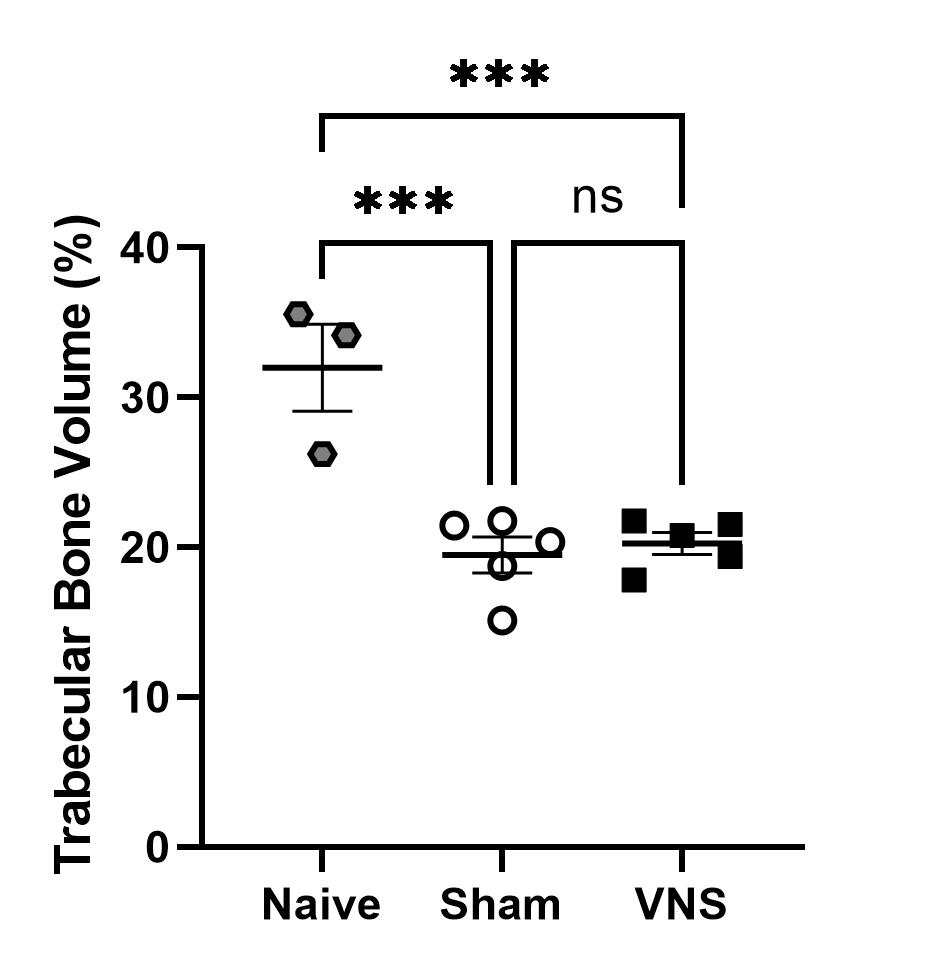Session Information
Date: Monday, November 13, 2023
Title: (0859–0885) Osteoarthritis & Joint Biology – Basic Science Poster
Session Type: Poster Session B
Session Time: 9:00AM-11:00AM
Background/Purpose: Electrical stimulation of the vagus nerve activates the inflammatory reflex to inhibit cytokines and decrease clinical signs and symptoms of chronic inflammatory disease such as rheumatoid arthritis (RA)1. Joint preservation (cartilage and bone) was reported in rat collagen induced arthritis and derosions were observed by MRI in early human clinical studies for treatment-resistant RA1,2. It is currently unclear whether the beneficial effects of vagus nerve stimulation on bone in RA are specific to bone remodeling, or are simply secondary to a decreased synovial inflammatory milieu. To separate the bone turnover-related effects from the amelioration of joint-specific inflammation, we stimulated the vagus nerve of rats with experimental autoimmune encephalomyelitis (EAE), a CNS-specific disease model with bone resorption as a known comorbidity.
Methods: Vagus nerve stimulation devices (SetPoint Medical, CA) were implanted in 6-week-old female Lewis rats. Following recovery, EAE was induced with myelin basic protein (0.1 mg/rat) and complete Freund’s adjuvant (Hooke Laboratories, CT). Conscious rats (n=5/group) were treated with active or sham stimulation from 7 days post-induction (DPI), the day prior to the typical onset of clinical neurologic symptoms, through 21 DPI. Cortical and trabecular bone parameters were calculated through µCT analysis of the proximal femurs and difference in means compared by ANOVA.
Results: On 21 DPI, both active and sham stimulated rats had a significant decrease in trabecular bone mineral density vs. naïve (Fig 1). Trabecular thickness was significantly higher in actively stimulated rats vs. sham (Fig 2). Cortical bone mineral density was numerically reduced in the sham, but not in the active stimulation group. There was a significant reduction in cortical bone volume in the sham, but not in the active stimulation group (Fig 3). *p < 0.05, **p < 0.01, ***p < 0.001
Conclusion: The data show that subacute vagus nerve stimulation enhances trabecular thickness and cortical bone volume in the femurs of rats with EAE. This is an important indicator of a bone-specific protective effect of vagus nerve stimulation, in addition to, and independent of, amelioration of joint-specific inflammation. Studies to further understand of the mechanisms of action are underway.
1 Genovese et al, Lancet Rheumatology S2665-9913(20)30172-7 (2020)
2 Levine et al, PLoS One 2014; 9(8):e104530
To cite this abstract in AMA style:
Natarajan C, Lucchino J, Chenoff D, Levine Y. Vagus Nerve Stimulation Enhances Bone Morphology in a Rodent Model of Central Nervous System Inflammation [abstract]. Arthritis Rheumatol. 2023; 75 (suppl 9). https://acrabstracts.org/abstract/vagus-nerve-stimulation-enhances-bone-morphology-in-a-rodent-model-of-central-nervous-system-inflammation/. Accessed .« Back to ACR Convergence 2023
ACR Meeting Abstracts - https://acrabstracts.org/abstract/vagus-nerve-stimulation-enhances-bone-morphology-in-a-rodent-model-of-central-nervous-system-inflammation/



